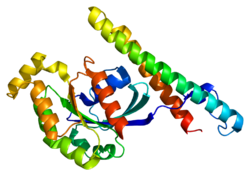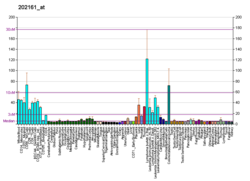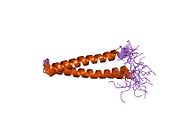Protein kinase N1
Serine/threonine-protein kinase N1 is an enzyme that in humans is encoded by the PKN1 gene.[5][6]
Function
The protein encoded by this gene belongs to the protein kinase C superfamily. This kinase is activated by Rho family of small G proteins and may mediate the Rho-dependent signaling pathway. This kinase can be activated by phospholipids and by limited proteolysis. The 3-phosphoinositide dependent protein kinase-1 (PDPK1/PDK1) is reported to phosphorylate this kinase, which may mediate insulin signals to the actin cytoskeleton. The proteolytic activation of this kinase by caspase-3 or related proteases during apoptosis suggests its role in signal transduction related to apoptosis. Alternatively spliced transcript variants encoding distinct isoforms have been observed.[6]
Interactions
Protein kinase N1 has been shown to interact with:
References
- ^ a b c GRCh38: Ensembl release 89: ENSG00000123143 – Ensembl, May 2017
- ^ a b c GRCm38: Ensembl release 89: ENSMUSG00000057672 – Ensembl, May 2017
- ^ "Human PubMed Reference:". National Center for Biotechnology Information, U.S. National Library of Medicine.
- ^ "Mouse PubMed Reference:". National Center for Biotechnology Information, U.S. National Library of Medicine.
- ^ Bartsch JW, Mukai H, Takahashi N, Ronsiek M, Fuchs S, Jockusch H, Ono Y (June 1998). "The protein kinase N (PKN) gene PRKCL1/Prkcl1 maps to human chromosome 19p12-p13.1 and mouse chromosome 8 with close linkage to the myodystrophy (myd) mutation". Genomics. 49 (1): 129–32. doi:10.1006/geno.1997.5208. PMID 9570957.
- ^ a b "Entrez Gene: PKN1 protein kinase N1".
- ^ Takahashi M, Shibata H, Shimakawa M, Miyamoto M, Mukai H, Ono Y (June 1999). "Characterization of a novel giant scaffolding protein, CG-NAP, that anchors multiple signaling enzymes to centrosome and the golgi apparatus". J. Biol. Chem. 274 (24): 17267–74. doi:10.1074/jbc.274.24.17267. PMID 10358086.
- ^ Feng S, Reséndiz JC, Christodoulides N, Lu X, Arboleda D, Berndt MC, Kroll MH (January 2002). "Pathological shear stress stimulates the tyrosine phosphorylation of alpha-actinin associated with the glycoprotein Ib-IX complex". Biochemistry. 41 (4): 1100–8. doi:10.1021/bi0156005. PMID 11802708.
- ^ Rual JF, Venkatesan K, Hao T, Hirozane-Kishikawa T, Dricot A, Li N, Berriz GF, Gibbons FD, Dreze M, Ayivi-Guedehoussou N, Klitgord N, Simon C, Boxem M, Milstein S, Rosenberg J, Goldberg DS, Zhang LV, Wong SL, Franklin G, Li S, Albala JS, Lim J, Fraughton C, Llamosas E, Cevik S, Bex C, Lamesch P, Sikorski RS, Vandenhaute J, Zoghbi HY, Smolyar A, Bosak S, Sequerra R, Doucette-Stamm L, Cusick ME, Hill DE, Roth FP, Vidal M (October 2005). "Towards a proteome-scale map of the human protein-protein interaction network". Nature. 437 (7062): 1173–8. Bibcode:2005Natur.437.1173R. doi:10.1038/nature04209. PMID 16189514. S2CID 4427026.
- ^ Mukai H, Toshimori M, Shibata H, Kitagawa M, Shimakawa M, Miyahara M, Sunakawa H, Ono Y (April 1996). "PKN associates and phosphorylates the head-rod domain of neurofilament protein". J. Biol. Chem. 271 (16): 9816–22. doi:10.1074/jbc.271.16.9816. PMID 8621664.
- ^ Shibata H, Oda H, Mukai H, Oishi K, Misaki K, Ohkubo H, Ono Y (December 1999). "Interaction of PKN with a neuron-specific basic helix-loop-helix transcription factor, NDRF/NeuroD2". Brain Res. Mol. Brain Res. 74 (1–2): 126–34. doi:10.1016/s0169-328x(99)00273-9. PMID 10640683.
- ^ Balendran A, Biondi RM, Cheung PC, Casamayor A, Deak M, Alessi DR (July 2000). "A 3-phosphoinositide-dependent protein kinase-1 (PDK1) docking site is required for the phosphorylation of protein kinase Czeta (PKCzeta ) and PKC-related kinase 2 by PDK1". J. Biol. Chem. 275 (27): 20806–13. doi:10.1074/jbc.M000421200. PMID 10764742.
- ^ Oishi K, Takahashi M, Mukai H, Banno Y, Nakashima S, Kanaho Y, Nozawa Y, Ono Y (May 2001). "PKN regulates phospholipase D1 through direct interaction". J. Biol. Chem. 276 (21): 18096–101. doi:10.1074/jbc.M010646200. PMID 11259428.
- ^ Riento K, Guasch RM, Garg R, Jin B, Ridley AJ (June 2003). "RhoE binds to ROCK I and inhibits downstream signaling". Mol. Cell. Biol. 23 (12): 4219–29. doi:10.1128/mcb.23.12.4219-4229.2003. PMC 156133. PMID 12773565.
- ^ Alberts AS, Bouquin N, Johnston LH, Treisman R (April 1998). "Analysis of RhoA-binding proteins reveals an interaction domain conserved in heterotrimeric G protein beta subunits and the yeast response regulator protein Skn7". J. Biol. Chem. 273 (15): 8616–22. doi:10.1074/jbc.273.15.8616. PMID 9535835.
- ^ Flynn P, Mellor H, Palmer R, Panayotou G, Parker PJ (January 1998). "Multiple interactions of PRK1 with RhoA. Functional assignment of the Hr1 repeat motif". J. Biol. Chem. 273 (5): 2698–705. doi:10.1074/jbc.273.5.2698. PMID 9446575.
- ^ Matsuzawa K, Kosako H, Inagaki N, Shibata H, Mukai H, Ono Y, Amano M, Kaibuchi K, Matsuura Y, Azuma I, Inagaki M (May 1997). "Domain-specific phosphorylation of vimentin and glial fibrillary acidic protein by PKN". Biochem. Biophys. Res. Commun. 234 (3): 621–5. doi:10.1006/bbrc.1997.6669. PMID 9175763.
- ^ Kato T, Gotoh Y, Hoffman A, Ono Y (May 2008). "Negative regulation of constitutive NF-kappaB and JNK signaling by PKN1-mediated phosphorylation of TRAF1". Genes Cells. 13 (5): 509–20. doi:10.1111/j.1365-2443.2008.01182.x. PMID 18429822. S2CID 205292893.
Further reading
- Palmer RH, Ridden J, Parker PJ (1995). "Cloning and expression patterns of two members of a novel protein-kinase-C-related kinase family". Eur. J. Biochem. 227 (1–2): 344–51. doi:10.1111/j.1432-1033.1995.tb20395.x. PMID 7851406.
- Chu W, Presky DH, Danho W, Swerlick RA, Burns DK (1994). "Identification and characterization of DBK, a novel putative serine/threonine protein kinase from human endothelial cells". Eur. J. Biochem. 225 (2): 695–702. doi:10.1111/j.1432-1033.1994.00695.x. PMID 7957185.
- Palmer RH, Ridden J, Parker PJ (1994). "Identification of multiple, novel, protein kinase C-related gene products". FEBS Lett. 356 (1): 5–8. doi:10.1016/0014-5793(94)01202-4. PMID 7988719. S2CID 32020105.
- Mukai H, Ono Y (1994). "A novel protein kinase with leucine zipper-like sequences: its catalytic domain is highly homologous to that of protein kinase C". Biochem. Biophys. Res. Commun. 199 (2): 897–904. doi:10.1006/bbrc.1994.1313. PMID 8135837.
- Palmer RH, Schönwasser DC, Rahman D, Pappin DJ, Herget T, Parker PJ (1996). "PRK1 phosphorylates MARCKS at the PKC sites: serine 152, serine 156 and serine 163". FEBS Lett. 378 (3): 281–5. doi:10.1016/0014-5793(95)01454-3. PMID 8557118. S2CID 46417714.
- Amano M, Mukai H, Ono Y, Chihara K, Matsui T, Hamajima Y, Okawa K, Iwamatsu A, Kaibuchi K (1996). "Identification of a putative target for Rho as the serine-threonine kinase protein kinase N". Science. 271 (5249): 648–50. Bibcode:1996Sci...271..648A. doi:10.1126/science.271.5249.648. PMID 8571127. S2CID 206575961.
- Mukai H, Toshimori M, Shibata H, Kitagawa M, Shimakawa M, Miyahara M, Sunakawa H, Ono Y (1996). "PKN associates and phosphorylates the head-rod domain of neurofilament protein". J. Biol. Chem. 271 (16): 9816–22. doi:10.1074/jbc.271.16.9816. PMID 8621664.
- Brown JL, Stowers L, Baer M, Trejo J, Coughlin S, Chant J (1996). "Human Ste20 homologue hPAK1 links GTPases to the JNK MAP kinase pathway". Curr. Biol. 6 (5): 598–605. Bibcode:1996CBio....6..598B. doi:10.1016/S0960-9822(02)00546-8. PMID 8805275. S2CID 9697114.
- Mukai H, Miyahara M, Sunakawa H, Shibata H, Toshimori M, Kitagawa M, Shimakawa M, Takanaga H, Ono Y (1996). "Translocation of PKN from the cytosol to the nucleus induced by stresses". Proc. Natl. Acad. Sci. U.S.A. 93 (19): 10195–9. Bibcode:1996PNAS...9310195M. doi:10.1073/pnas.93.19.10195. PMC 38360. PMID 8816775.
- Mukai H, Toshimori M, Shibata H, Takanaga H, Kitagawa M, Miyahara M, Shimakawa M, Ono Y (1997). "Interaction of PKN with alpha-actinin". J. Biol. Chem. 272 (8): 4740–6. doi:10.1074/jbc.272.8.4740. PMID 9030526.
- Matsuzawa K, Kosako H, Inagaki N, Shibata H, Mukai H, Ono Y, Amano M, Kaibuchi K, Matsuura Y, Azuma I, Inagaki M (1997). "Domain-specific phosphorylation of vimentin and glial fibrillary acidic protein by PKN". Biochem. Biophys. Res. Commun. 234 (3): 621–5. doi:10.1006/bbrc.1997.6669. PMID 9175763.
- Goedert M, Hasegawa M, Jakes R, Lawler S, Cuenda A, Cohen P (1997). "Phosphorylation of microtubule-associated protein tau by stress-activated protein kinases". FEBS Lett. 409 (1): 57–62. doi:10.1016/S0014-5793(97)00483-3. PMID 9199504. S2CID 36383041.
- Flynn P, Mellor H, Palmer R, Panayotou G, Parker PJ (1998). "Multiple interactions of PRK1 with RhoA. Functional assignment of the Hr1 repeat motif". J. Biol. Chem. 273 (5): 2698–705. doi:10.1074/jbc.273.5.2698. PMID 9446575.
- Bekri S, Adélaïde J, Merscher S, Grosgeorge J, Caroli-Bosc F, Perucca-Lostanlen D, Kelley PM, Pébusque MJ, Theillet C, Birnbaum D, Gaudray P (1997). "Detailed map of a region commonly amplified at 11q13-->q14 in human breast carcinoma". Cytogenet. Cell Genet. 79 (1–2): 125–31. doi:10.1159/000134699. PMID 9533029.
- Zheng-Fischhöfer Q, Biernat J, Mandelkow EM, Illenberger S, Godemann R, Mandelkow E (1998). "Sequential phosphorylation of Tau by glycogen synthase kinase-3beta and protein kinase A at Thr212 and Ser214 generates the Alzheimer-specific epitope of antibody AT100 and requires a paired-helical-filament-like conformation". Eur. J. Biochem. 252 (3): 542–52. doi:10.1046/j.1432-1327.1998.2520542.x. PMID 9546672.
- Takanaga H, Mukai H, Shibata H, Toshimori M, Ono Y (1998). "PKN interacts with a paraneoplastic cerebellar degeneration-associated antigen, which is a potential transcription factor". Exp. Cell Res. 241 (2): 363–72. doi:10.1006/excr.1998.4060. PMID 9637778.
- Takahashi M, Mukai H, Toshimori M, Miyamoto M, Ono Y (1998). "Proteolytic activation of PKN by caspase-3 or related protease during apoptosis". Proc. Natl. Acad. Sci. U.S.A. 95 (20): 11566–71. Bibcode:1998PNAS...9511566T. doi:10.1073/pnas.95.20.11566. PMC 21681. PMID 9751706.
- Hanger DP, Betts JC, Loviny TL, Blackstock WP, Anderton BH (1998). "New phosphorylation sites identified in hyperphosphorylated tau (paired helical filament-tau) from Alzheimer's disease brain using nanoelectrospray mass spectrometry". J. Neurochem. 71 (6): 2465–76. doi:10.1046/j.1471-4159.1998.71062465.x. PMID 9832145. S2CID 45602824.
- Takahashi M, Shibata H, Shimakawa M, Miyamoto M, Mukai H, Ono Y (1999). "Characterization of a novel giant scaffolding protein, CG-NAP, that anchors multiple signaling enzymes to centrosome and the golgi apparatus". J. Biol. Chem. 274 (24): 17267–74. doi:10.1074/jbc.274.24.17267. PMID 10358086.







